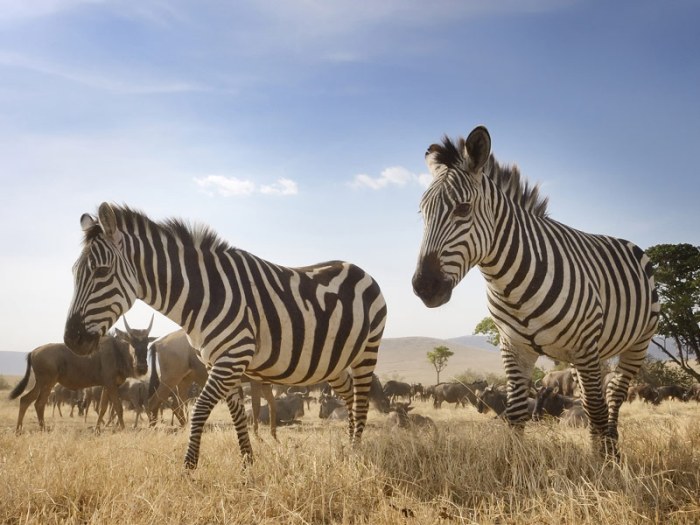
Wildlife travel destinations for animal lovers: Embark on a journey to explore the top 5 destinations worldwide, offering unique wildlife experiences that captivate the hearts of animal enthusiasts.
From encountering majestic creatures in their natural habitats to delving into responsible wildlife viewing practices, these destinations promise unforgettable adventures for wildlife lovers.
Wildlife Travel Destinations for Animal Lovers
For those who have a deep appreciation for wildlife and a love for animals, there are several incredible destinations around the world that offer unique experiences to observe and interact with a variety of species in their natural habitats. These destinations are popular among animal lovers for their diverse ecosystems and the opportunity to witness some of the most fascinating creatures on Earth up close.
1. Serengeti National Park, Tanzania
The Serengeti National Park in Tanzania is renowned for its vast savannahs and the annual Great Migration of wildebeest and zebra. Visitors can witness this natural spectacle as well as see the Big Five – lions, elephants, leopards, rhinos, and buffaloes – in their natural habitat.
2. Galapagos Islands, Ecuador
The Galapagos Islands are a unique archipelago known for their diverse wildlife, including giant tortoises, marine iguanas, and blue-footed boobies. Visitors can snorkel with sea lions, observe unique bird species, and learn about the ongoing conservation efforts on the islands.
3. Ranthambore National Park, India
Ranthambore National Park is one of the best places in India to spot Bengal tigers in the wild. In addition to tigers, the park is home to leopards, sloth bears, and a variety of bird species, making it a paradise for wildlife enthusiasts.
4. Maasai Mara National Reserve, Kenya
The Maasai Mara National Reserve in Kenya is famous for its population of lions, cheetahs, and wildebeest. Visitors can witness the Great Migration, as well as see a wide variety of other wildlife species, making it a prime destination for safari lovers.
5. Borneo, Malaysia
Borneo is a biodiversity hotspot and home to unique wildlife such as orangutans, pygmy elephants, and proboscis monkeys. Visitors can explore the rainforests, spot rare bird species, and learn about conservation efforts to protect the diverse ecosystems on the island.
Outdoor Activities
When visiting wildlife travel destinations, animal lovers have the opportunity to engage in a variety of outdoor activities that allow them to immerse themselves in nature and observe wildlife in their natural habitats.
Guided Wildlife Safaris
- Embark on guided wildlife safaris to explore the wilderness and spot a diverse range of animals.
- Listen to expert guides who provide valuable insights about the wildlife and their behaviors.
- Opt for early morning or late afternoon safaris for the best chances of wildlife sightings.
Hiking and Nature Walks
- Take scenic hikes and nature walks to observe animals up close in their natural environment.
- Respect wildlife habitats by staying on designated trails and maintaining a safe distance from the animals.
- Carry binoculars and a camera to capture memorable moments without disturbing the wildlife.
Kayaking and Canoeing
- Experience a unique perspective of wildlife by kayaking or canoeing along rivers and waterways.
- Observe aquatic animals such as birds, otters, and fish while gliding through serene waters.
- Practice responsible boating etiquette to minimize disruptions to wildlife and their habitats.
Photography Tours
- Join photography tours led by experienced wildlife photographers to improve your photography skills.
- Capture stunning images of wildlife in their natural surroundings while learning about composition and lighting.
- Respect wildlife by avoiding flash photography and loud noises that can startle or disturb them.
Volunteer Conservation Projects
- Participate in volunteer conservation projects to contribute to wildlife protection and habitat restoration efforts.
- Engage in activities such as tree planting, wildlife monitoring, and environmental education programs.
- Support conservation organizations that prioritize the well-being of wildlife and promote sustainable tourism practices.
Travelling and Hotels
When planning a wildlife travel adventure, choosing wildlife-friendly accommodations is crucial to ensure that your stay does not harm the environment or the animals you are there to see. By opting for eco-friendly hotels near wildlife reserves or national parks, you can minimize your impact on the surrounding ecosystems and support conservation efforts.
Recommendations for Eco-Friendly Hotels
- Look for hotels that have been certified by reputable eco-tourism organizations, such as EarthCheck or Green Key, which have strict sustainability criteria in place.
- Choose accommodations that have implemented energy-saving practices, such as using solar power or energy-efficient lighting, to minimize their carbon footprint.
- Support hotels that prioritize waste reduction and recycling initiatives to help minimize the amount of waste generated during your stay.
- Opt for hotels that source their food locally and prioritize organic and sustainable ingredients to support local communities and reduce the environmental impact of food transportation.
Contributing to Wildlife Conservation Efforts
Staying at sustainable hotels can contribute to wildlife conservation efforts in various ways. By supporting eco-friendly accommodations, you are helping to reduce the overall environmental impact of tourism on wildlife habitats. Additionally, many sustainable hotels actively participate in conservation projects and community initiatives that aim to protect and preserve the local wildlife and ecosystems.
Your choice to stay at a wildlife-friendly hotel can make a positive impact on the environment and help support the long-term conservation of the wildlife you have traveled to see.
Holidays and Vacations
Planning a wildlife-focused holiday can be an exciting and fulfilling experience for animal lovers. Whether you are traveling with your family or going solo, there are some key considerations to keep in mind to ensure you make the most of your trip.
Best Time of Year to Visit Wildlife Travel Destinations
When planning your wildlife travel destination, it’s essential to consider the best time of year to visit for optimal animal sightings. This can vary depending on the location and the specific animals you want to see. For example, if you are interested in witnessing the Great Migration in Africa, the best time to visit would be during the dry season from July to September when the animals are on the move.
Planning Wildlife-Focused Holidays and Vacations
When planning your wildlife-focused holiday, make sure to research the destination thoroughly to understand the local wildlife, the best time to visit, and any necessary permits or guided tours required. Consider staying in eco-friendly accommodations to minimize your impact on the environment and support conservation efforts.
Additionally, booking wildlife-focused activities in advance can help ensure you don’t miss out on unique experiences like safaris, bird watching tours, or animal encounters.
Anecdotes or Personal Experiences
Sharing personal anecdotes from wildlife-focused holidays can inspire others to embark on their own adventures. Whether it’s a memorable encounter with a rare animal, witnessing a breathtaking wildlife spectacle, or simply enjoying the tranquility of nature, these experiences can stay with you for a lifetime.
Consider joining wildlife conservation programs or volunteering opportunities during your travels to make a positive impact and create lasting memories.
Vacation Plans
Planning a wildlife-focused vacation can be an exciting and rewarding experience for animal lovers. Here is a step-by-step guide to help you plan the perfect wildlife travel adventure.
Booking Accommodations and Activities
When planning your wildlife vacation, start by researching accommodations that are located close to the wildlife reserves or national parks you wish to visit. Look for eco-friendly lodges or campsites that offer guided wildlife tours and activities. Make sure to book your accommodations well in advance to secure your spot during peak travel seasons.
Creating a Flexible Itinerary
It is essential to create a flexible itinerary when planning a wildlife travel adventure. Wildlife sightings can be unpredictable, so allow for some flexibility in your schedule to maximize your chances of spotting animals in their natural habitat. Leave room for spontaneous wildlife encounters and adjust your plans as needed based on weather conditions and animal behavior.
Budgeting for Wildlife Travel
Budgeting is an important aspect of planning a wildlife vacation. Research the costs associated with accommodations, transportation, guided tours, park entrance fees, and meals to create a realistic budget for your trip. Consider booking all-inclusive packages or group tours to save money on travel expenses.
Look for off-peak travel deals and discounts to make the most of your wildlife travel budget.
Hidden Gem Wildlife Travel Spot: Selous Game Reserve, Tanzania

Selous Game Reserve in Tanzania is a lesser-known wildlife travel spot that is a hidden gem for animal lovers. This off-the-beaten-path destination offers a unique opportunity to experience a diverse range of flora and fauna in a pristine and untouched natural setting.
Unique Flora and Fauna
Selous Game Reserve is home to a variety of wildlife, including elephants, lions, leopards, and hippos. The reserve is also known for its diverse bird species, making it a paradise for birdwatchers. The lush vegetation and winding rivers provide a picturesque backdrop for observing these majestic animals in their natural habitat.
Tips for Access and Wildlife Experiences
To access Selous Game Reserve, you can fly into the nearby airstrip or take a scenic drive from Dar es Salaam. Once in the reserve, guided safari tours are the best way to explore the area and spot wildlife. Consider staying at one of the luxury lodges or tented camps within the reserve for a truly immersive experience.
Best Travel Backpack

When embarking on a wildlife adventure, having the right travel backpack is essential for a comfortable and organized experience. A good travel backpack should be durable, lightweight, and have enough compartments to store all your essentials securely.
Essential Items to Pack
- Water bottle: Stay hydrated during long hikes and outdoor activities.
- Sunscreen and insect repellent: Protect your skin from harmful UV rays and pesky bugs.
- First aid kit: Be prepared for any minor injuries or emergencies.
- Binoculars: Enhance your wildlife viewing experience by getting a closer look at animals.
- Snacks: Keep your energy levels up with quick and easy snacks like trail mix or energy bars.
Recommended Travel Backpacks
- Osprey Atmos AG 65: Known for its comfort and ventilation system, perfect for long hikes.
- REI Co-op Flash 55: Lightweight and versatile, ideal for backpacking trips and outdoor adventures.
- Patagonia Black Hole 32L: Durable and water-resistant, great for protecting your gear in unpredictable weather conditions.
Tips for Efficient Packing
- Roll your clothes to save space and prevent wrinkles.
- Use packing cubes to keep your belongings organized and easily accessible.
- Pack versatile clothing items that can be layered for different weather conditions.
- Keep important documents like passports and travel insurance information in a secure, waterproof pouch.
Travel Tip
When planning a wildlife-focused trip, it is essential for animal lovers to prioritize safety, respect for wildlife, and their habitats. Here are some valuable travel tips to ensure a memorable and responsible experience:
Stay Informed and Prepared
- Research the wildlife species you may encounter and their behaviors to understand how to safely observe them from a distance.
- Pack appropriate gear such as binoculars, a camera with a zoom lens, sturdy walking shoes, and lightweight clothing for outdoor activities.
- Follow the guidelines provided by park authorities or tour guides to minimize any negative impact on the environment and wildlife.
Stay Safe While Exploring Wildlife Destinations
- Avoid approaching or feeding wild animals as it can alter their natural behaviors and pose a danger to both you and the animals.
- Stay on designated trails and paths to avoid disturbing the habitats of wildlife and to prevent getting lost in unfamiliar terrain.
- Be cautious around water bodies where wildlife may gather, as some animals may perceive humans as a threat to their territory.
Respect Wildlife and Their Habitats
- Observe animals from a safe distance and avoid making loud noises or sudden movements that could startle them.
- Avoid littering or leaving any traces of your visit behind, as this can harm the environment and disrupt the natural balance of ecosystems.
- Do not pick flowers, disturb nests, or interfere with the natural surroundings to maintain the integrity of the wildlife habitats.
Travel News
Stay up to date with the latest trends and developments in wildlife travel and ecotourism, as well as conservation efforts in popular wildlife travel destinations. Learn about any new regulations or changes affecting wildlife tourism.
Conservation Efforts in Wildlife Travel Destinations
Conservation efforts in wildlife travel destinations play a crucial role in protecting endangered species and preserving natural habitats. Here are some updates on conservation initiatives in popular wildlife travel spots:
- The Maasai Mara National Reserve in Kenya has launched a new anti-poaching program to combat illegal wildlife trade and protect its diverse wildlife population.
- In the Galapagos Islands, strict regulations have been implemented to control visitor impact on the delicate ecosystem, ensuring the preservation of unique species found nowhere else on Earth.
- The Ranthambore National Park in India has introduced community-based conservation projects to involve local communities in wildlife protection and habitat restoration efforts.
New Regulations Impacting Wildlife Tourism
Changes in regulations can have a significant impact on wildlife tourism, affecting visitor experiences and wildlife conservation efforts. Stay informed about the latest developments in wildlife tourism regulations:
- Costa Rica has implemented new guidelines for sustainable tourism practices in its national parks and reserves, encouraging responsible visitor behavior and supporting conservation projects.
- In Australia, stricter rules have been introduced to minimize human-wildlife interactions in popular wildlife viewing areas, aiming to protect both wildlife and visitors.
- The Serengeti National Park in Tanzania has revised its safari vehicle guidelines to reduce disturbance to wildlife and enhance the overall safari experience for visitors.
Best Travel Destinations
When it comes to wildlife travel destinations for animal lovers, there are two popular options that stand out: Maasai Mara National Reserve in Kenya and Galapagos Islands in Ecuador. Both destinations offer unique experiences and opportunities to observe diverse wildlife in their natural habitats.
Maasai Mara National Reserve, Kenya, Wildlife travel destinations for animal lovers
The Maasai Mara National Reserve is famous for its vast savannah grasslands teeming with wildlife, especially during the Great Migration when millions of wildebeest, zebras, and other animals cross the Mara River. Visitors to Maasai Mara can witness this incredible spectacle and also spot the Big Five – lions, elephants, buffaloes, leopards, and rhinos.
The reserve is also home to the Maasai people, adding a cultural element to the overall experience.
Galapagos Islands, Ecuador
The Galapagos Islands are a UNESCO World Heritage Site known for their unique and diverse wildlife, including giant tortoises, marine iguanas, blue-footed boobies, and Galapagos penguins. Visitors to the Galapagos can explore the various islands through guided tours and witness up close the fascinating adaptations of the animals to their isolated island habitats.
Snorkeling and diving opportunities also allow for unforgettable encounters with marine life.
Recommendations
- If you are interested in witnessing the Great Migration and spotting the Big Five, Maasai Mara National Reserve in Kenya is the ideal choice.
- For a more unique and diverse wildlife experience, especially in marine environments, the Galapagos Islands in Ecuador would be the preferred destination.
- Consider your specific interests and preferences when choosing between the two destinations to ensure you have a truly memorable wildlife travel experience.
Closing Summary
In conclusion, Wildlife travel destinations for animal lovers present a world of wonder and discovery, where nature’s beauty and wildlife conservation efforts intertwine to create memorable experiences for travelers seeking to connect with the animal kingdom.
FAQ Section
What are the best wildlife travel destinations for animal lovers?
The top 5 wildlife travel destinations worldwide are Africa (Serengeti, Maasai Mara), Galapagos Islands, Costa Rica, Borneo, and Antarctica.
What outdoor activities can animal lovers engage in at wildlife travel destinations?
Outdoor activities like safari tours, bird watching, snorkeling, hiking, and wildlife photography are popular choices for animal lovers to immerse themselves in nature.
How can staying at wildlife-friendly accommodations contribute to conservation efforts?
Choosing eco-friendly hotels near wildlife reserves or national parks supports sustainable tourism practices and helps in the conservation of wildlife habitats.







